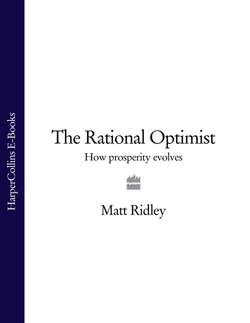Читать книгу The Rational Optimist: How Prosperity Evolves - Matt Ridley, Matt Ridley - Страница 17
Arcadia redux
ОглавлениеYet, surely, long ago, before trade, technology and farming, human beings lived simple, organic lives in harmony with nature. That was not poverty: that was ‘the original affluent society’. Take a snapshot of the life of hunter-gathering human beings in their heyday, say at 15,000 years ago well after the taming of the dog and the extermination of the woolly rhinoceros but just before the colonisation of the Americas. People had spear throwers, bows and arrows, boats, needles, adzes, nets. They painted exquisite art on rocks, decorated their bodies, traded foods, shells, raw materials and ideas. They sang songs, danced rituals, told stories, prepared herbal remedies for illnesses. They lived into old age far more frequently than their ancestors had done.
They had a way of life that was sufficiently adaptable to work in almost any habitat or climate. Where every other species needed its niche, the hunter-gatherer could make a niche out of anything: seaside or desert, arctic or tropical, forest or steppe.
A Rousseauesque idyll? The hunter-gatherers certainly looked like noble savages: tall, fit, healthy, and (having replaced stabbing spears with thrown ones) with fewer broken bones than Neanderthals. They ate plenty of protein, not much fat and ample vitamins. In Europe, with the help of increasing cold, they had largely wiped out the lions and hyenas that had both competed with and preyed upon their predecessors, so they had little to fear from wild animals. No wonder nostalgia for the Pleistocene runs through many of today’s polemics against consumerism. Geoffrey Miller, for example, in his excellent book Spent, asks his readers to imagine a Cro-Magnon mother of 30,000 years ago living ‘in a close-knit clan of family and friends…gathering organic fruits and vegetables…grooming, dancing, drumming and singing with people she knows, likes and trusts…the sun rising over the six thousand acres of verdant French Riviera coast that her clan holds.’
Life was good. Or was it? There was a serpent in the hunter-gatherer Eden – a savage in the noble savage. Maybe it was not a lifelong camping holiday after all. For violence was a chronic and ever-present threat. It had to be, because – in the absence of serious carnivore predation upon human beings – war kept the population density below the levels that brought on starvation. ‘Homo homini lupus’, said Plautus. ‘Man is a wolf to man.’ If hunter-gatherers appeared lithe and healthy it was because the fat and slow had all been shot in the back at dawn.
Here is the data. From the !Kung in the Kalahari to the Inuit in the Arctic, two-thirds of modern hunter-gatherers have proved to be in a state of almost constant tribal warfare, and 87 per cent to experience annual war. War is a big word for dawn raids, skirmishes and lots of posturing, but because these happen so often, death rates are high – usually around 30 per cent of adult males dying from homicide. The warfare death rate of 0.5 per cent of the population per year that was typical of many hunter-gatherer societies would equate to two billion people dying during the twentieth century (instead of 100 million). At a cemetery uncovered at Jebel Sahaba, in Egypt, dating from 14,000 years ago, twenty-four of the fifty-nine bodies had died from unhealed wounds caused by spears, darts and arrows. Forty of these bodies were women or children. Women and children generally do not take part in warfare – but they are frequently the object of the fighting. To be abducted as a sexual prize and see your children killed was almost certainly not a rare female fate in hunter-gatherer society. After Jebel Sahaba, forget the Garden of Eden; think Mad Max.
It was not just warfare that limited population growth. Hunter-gatherers are often vulnerable to famines. Even when food is abundant, it might take so much travelling and trouble to collect enough food that women would not maintain a sufficient surplus to keep themselves fully fertile for more than a few prime years. Infanticide was a common resort in bad times. Nor was disease ever far away: gangrene, tetanus and many kinds of parasite would have been big killers. Did I mention slavery? Common in the Pacific north-west. Wife beating? Routine in Tierra del Fuego. The lack of soap, hot water, bread, books, films, metal, paper, cloth? When you meet one of those people who go so far as to say they would rather have lived in some supposedly more delightful past age, just remind them of the toilet facilities of the Pleistocene, the transport options of Roman emperors or the lice of Versailles.
